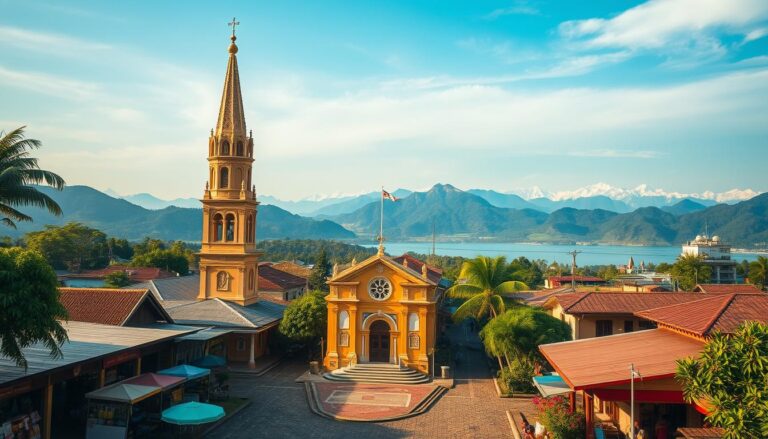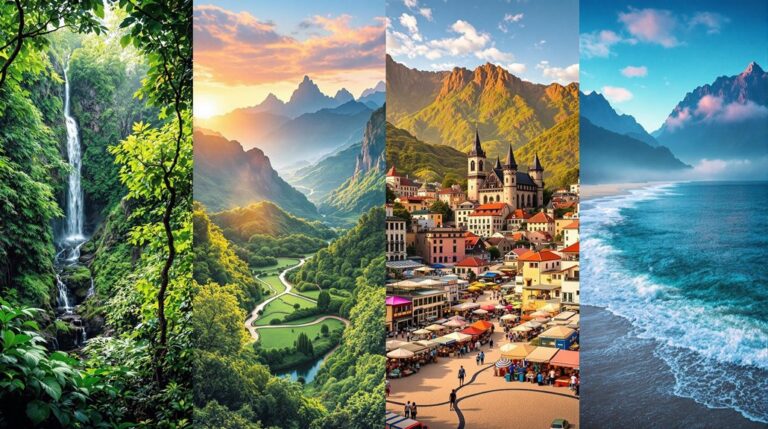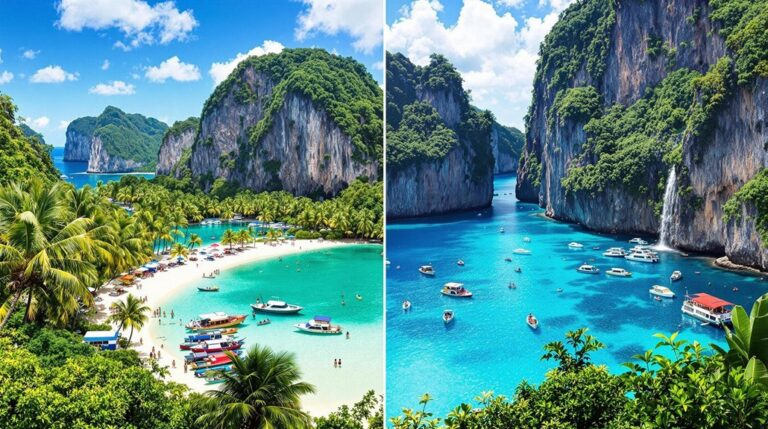Best Time to Visit Philippines: Weather Guide for US Tourists
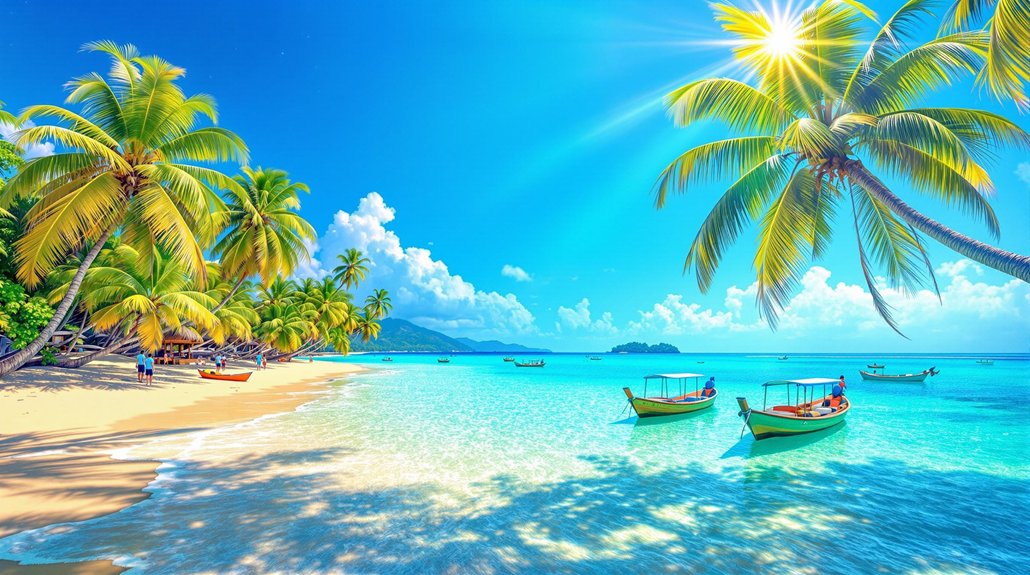
To enjoy your trip to the Philippines, visit between November and April. During this time, the weather is dry with clear skies and comfortable temperatures, making it perfect for beach activities and exploring local festivals. January and February are cooler, ideal for cultural events, while March to May are warmer, great for festivals and water sports.
It’s wise to avoid visiting from June to September due to the risk of typhoons. Each region has its unique weather and adventures to offer, providing diverse experiences for travelers.
Highlights
- Visit the Philippines between November and April when the weather is dry and skies are clear, perfect for enjoying its beautiful beaches and islands. For those interested in cultural events and outdoor activities, January and February are great months as the temperatures are cooler.
- It’s best to skip July and August due to the risk of typhoons, ensuring a safer trip. Enthusiasts of surfing and diving will find May and November ideal, thanks to warm waters and diverse marine life.
- Luzon is sunny from November to April, making it a great time for beach visits, while Mindanao’s weather is consistently good for exploring all year round.
Understanding the Philippines’ Climate
When planning a trip to the Philippines, it’s crucial to understand its varied climate to make the most of your visit. The islands are set in lush tropical environments, where the humidity often amplifies the heat. The average temperature is around 27°C, but the climate changes significantly from one region to another.
For example, tropical rainforests thrive in the mountainous areas, while higher altitudes have humid subtropical climates. The geography, featuring volcanic and coral landscapes, coastal plains, and large lakes, creates unique microclimates.
Seasonal Breakdown: Dry vs. Wet
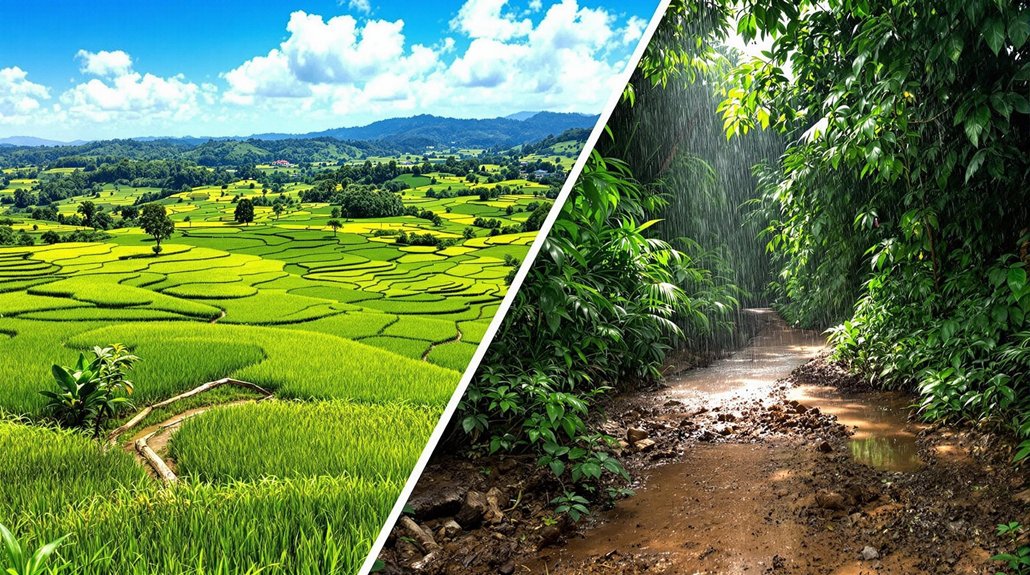
When planning a trip to the Philippines, it’s important to know the differences between the dry and wet seasons.
The dry season, with clear skies and pleasant temperatures, is ideal for enjoying beaches, exploring islands, and joining local festivals.
On the other hand, the wet season brings lots of rain and sometimes typhoons, which can disrupt travel and outdoor plans.
Knowing this helps you choose the best time to visit based on your interests.
Dry Season Highlights
The Philippines is known for its great weather all year, but the dry season from November to April is particularly good for travel.
During this time, you can enjoy sunny days and warm temperatures, making it perfect for exploring islands and experiencing festivals.
With less humidity, it’s also a great time for outdoor activities.
Here are some reasons to visit:
- Island Hopping: Discover the calm and inviting waters of El Nido or Coron, perfect for swimming and snorkeling.
- Festival Fun: Dive into lively events like Ati-Atihan in Panay or Sinulog in Cebu to experience local culture firsthand.
- Beach Getaways: Enjoy the famous white sands of Boracay, perfect for both relaxation and water sports.
Wet Season Challenges
While the dry season in the Philippines offers sunny adventures, the wet season from May to October brings its own challenges.
Frequent rain and potential typhoons can disrupt travel plans and damage infrastructure. It’s important to be prepared for flooding and landslides by having rain gear and emergency supplies ready.
The increased humidity also raises the risk of mosquito-borne diseases like dengue fever and malaria. Staying informed and cautious is key to enjoying your trip during this season.
Monthly Weather Overview
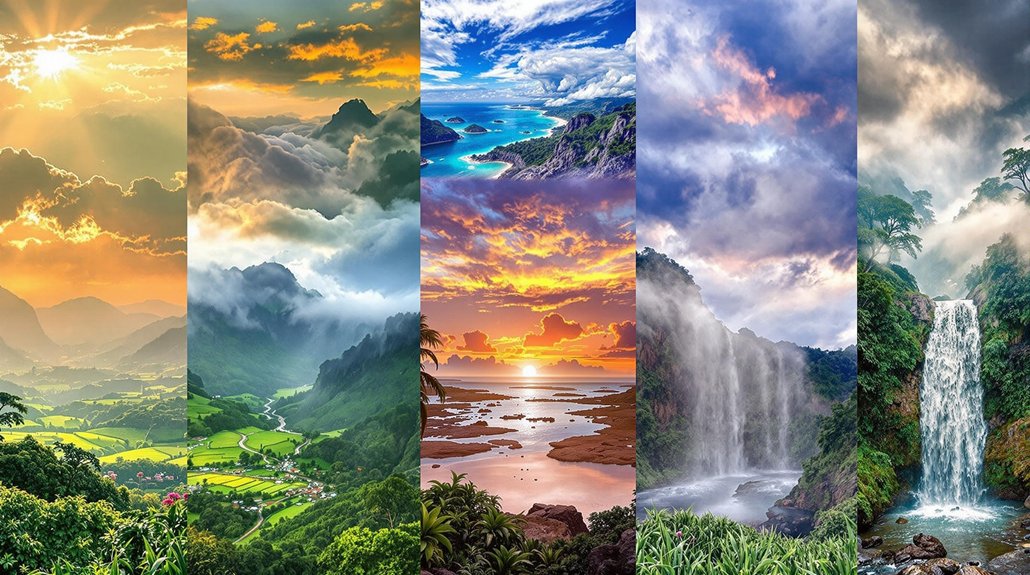
Cooler Months: January-February
January and February in the Philippines offer a wonderful time to visit because of the pleasant weather during these cooler months.
With temperatures between 24°C and 31°C, it’s ideal for enjoying cultural festivals and outdoor activities. You can immerse yourself in events like the Ati-Atihan and Sinulog festivals, showcasing the country’s rich traditions.
Here are three reasons to make the most of your visit:
- Dry Weather: With low humidity and minimal rain, you can explore historic sites and nature reserves without concern.
- Perfect for Outdoor Activities: The dry season is great for hiking mountain trails or diving in clear waters.
- Vibrant Atmosphere: Although popular spots are busy, booking in advance ensures you don’t miss the excitement.
Hottest Period: March-May
Get ready for the hottest time in the Philippines from March to May. Temperatures can reach up to 34°C, especially during April and May. It’s a popular time for tourism, with lively festivals and lots of beach activities.
| Month | Temperature Range |
|---|---|
| March | 25°C – 32°C |
| April | 32°C – 34°C |
| May | Above 32°C |
Coastal spots like Boracay and El Nido are busy with visitors, while cooler places like Baguio offer a refreshing change. Enjoy surfing in Siargao and exploring the natural beauty of Camiguin. It’s a good idea to book accommodations early, especially around Easter, to save on costs and fully enjoy the local culture.
Rainy Season: June-October
As the sunny skies of the dry season give way, the Philippines becomes a lush, vibrant haven during the rainy months from June to October. This time of year has its own charm, with warm temperatures between 77°F and 91°F.
To make the most of this season, try these activities:
- Explore Nature: Visit the beautiful karst landscapes of places like El Nido and Coron. With fewer crowds, you can enjoy the thriving natural environment more peacefully.
- Plan Ahead with Travel Insurance: Typhoons can be unpredictable, so having travel insurance can offer peace of mind during your trip.
- Enjoy Cultural Festivals: Experience events such as the Kadayawan sa Davao in August. These festivals celebrate the rich culture and traditions, adding a vibrant touch to the rainy days.
Regional Weather Variations
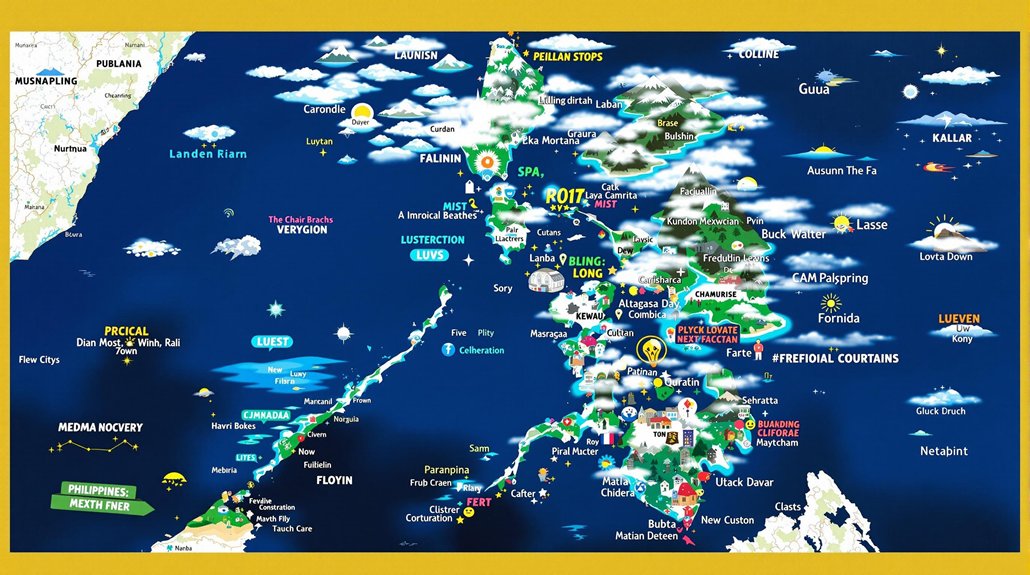
The Philippines has a tropical maritime climate, but each region offers its own weather patterns.
Luzon has distinct dry and wet seasons. From November to April, expect sunny beaches and vibrant inland adventures. Starting in May, eastern Luzon becomes lush and green due to increased rainfall.
Visayas follows a similar pattern, with more rain in the east because of monsoon winds.
In contrast, Mindanao enjoys a stable climate, ideal for exploring any time of the year.
Navigating Typhoon Season
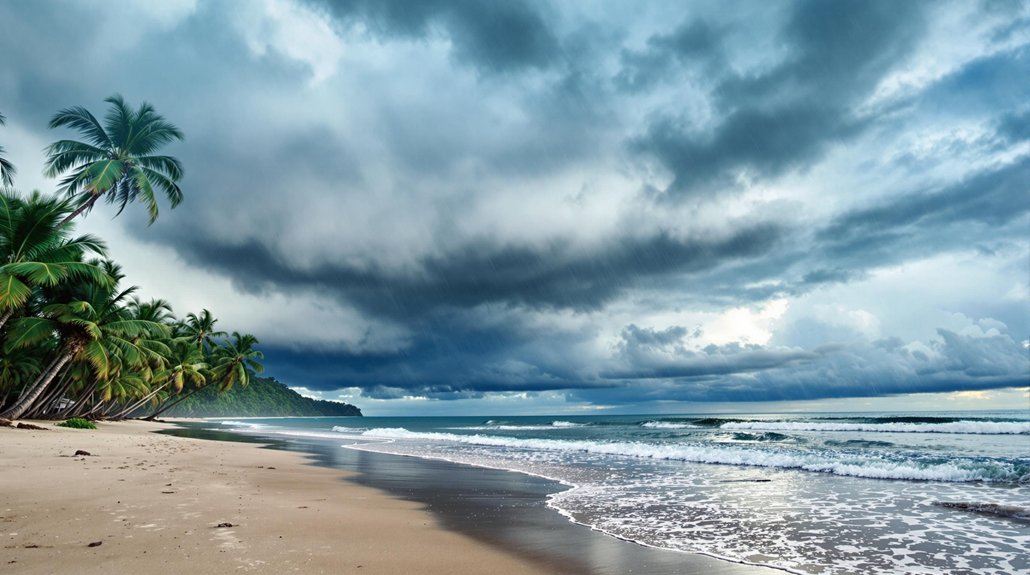
Planning a trip to the Philippines during typhoon season requires some preparation to ensure a safe and enjoyable experience. The country experiences about 19 typhoons each year, primarily from June to September.
Here are some tips to help you navigate this season effectively:
- Track Typhoons: Use trusted websites or apps to monitor storm paths and updates, helping you adjust your travel plans as needed.
- Choose the Right Time: To avoid disruptions, it’s best to visit outside the peak typhoon months of July and August. Consider traveling in May or November for a more relaxed experience.
- Have a Backup Plan: Prepare alternative itineraries and consider inland destinations, which are less affected by storms. This ensures a pleasant trip no matter the weather conditions.
Climate Change and Its Effects
As you plan your trip during the unpredictable typhoon season, it’s important to consider how climate change affects the Philippines’ weather. This chain of islands faces threats like rising sea levels and stronger typhoons, which might disrupt your travel. The government is investing in solutions like preventing deforestation and reducing pollution to handle these challenges.
It’s not just about the economy; protecting nature is crucial too. For example, a million hectares of grasslands are at risk, and coral reefs are declining.
These ecosystems need protection as changing rainfall and higher temperatures affect the Philippines’ unique wildlife and communities. Engaging with these challenges can enhance your journey and show you the country’s vibrant spirit.
Travel Tips for Different Seasons
Understanding the Philippines’ seasons is key to a great trip. During the dry season, pack light clothes, sunscreen, and insect repellent, perfect for places like Boracay and Palawan.
Stay hydrated as temperatures can hit 35°C (95°F). In the rainy season, bring waterproof gear and check weather updates for typhoon warnings.
Here are some activity ideas:
- Cool-Dry Festivities: From November to February, enjoy festivals like Sinulog, which are colorful and lively events. The Sinulog Festival is celebrated on the third Sunday of January and includes religious processions and vibrant street parades.
- Outdoor Adventures: January offers clear skies, ideal for exploring remote islands.
- Surfing & Diving: May and November are great for these water activities, thanks to the favorable conditions.
Frequently Asked Questions
What Cultural Festivals Coincide With the Best Weather for Visiting?
Experience the vibrant cultural festivals of the Philippines during the dry season. Events like Ati-Atihan, Sinulog, and Panagbenga take place when the weather is sunny and pleasant. These festivals are important because they showcase the country’s rich traditions through lively street performances and colorful parades.
Are There Any Local Weather Apps Recommended for Travelers?
When you’re traveling, it’s crucial to have reliable weather apps. Consider using Philippine Weather Forecast or Weather Philippines for real-time weather updates in the Philippines. Staying informed about the weather helps you plan your activities better and ensures you’re ready for any changes, making your trip more enjoyable.
How Do Local Communities Prepare for the Changing Weather Patterns?
Local communities are taking action to tackle changing weather patterns. They are focusing on practical steps like managing floods, adjusting crops, and strengthening infrastructure. These actions help protect the community and its resources. Additionally, they organize informative workshops and local events to ensure everyone knows how to handle weather challenges effectively.
What Are the Best Local Dishes to Enjoy During Specific Seasons?
You can enjoy special dishes that match the season. In the dry season, try lechon at festive gatherings. It’s a roasted pig dish that many people love for its crispy skin and juicy meat. During the rainy months, warm up with sinigang na baka, a comforting beef soup with a tangy flavor from tamarind. In the shoulder months, try pancit Malabon, a noodle dish with a mix of seafood and savory flavors. Each season offers unique foods that showcase local ingredients and cooking styles.
How Does the Weather Affect Wildlife and Nature Tours?
Weather plays a significant role in wildlife behavior and nature tours. For instance, it can affect animal migration patterns, which in turn might limit your chances of capturing great nature photos. Severe storms can interrupt tours, but they also offer you the chance to see how wildlife adapts to changing conditions. This can be a unique experience, especially for those who love adventure and exploring nature’s resilience.



